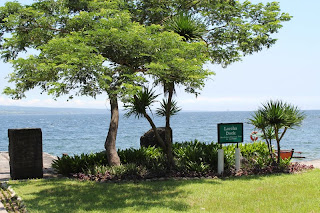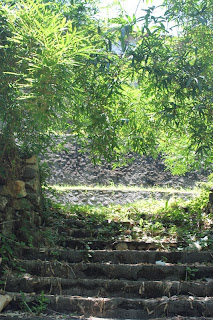A trip to Corregidor Island is worth the time. The day was beautiful for exploring the island. We took the Sun Cruises one hour ferry out to the island. (It is the ONLY way out there, so we did not have much of a choice) I found in refreshing that before we set out the on board televisions played a recorded pray for our safe journey instead of the safety spiel that usually comes before boarding a plane/train/boat.
Stepping off the ferry, I had no idea this beautiful island held such a complex and tormented history. Books and volumes of papers have been written about it, so here is my take in one paragraph:
 Corregidor Island is one of five islands guarding the mouth of Manila Bay. It was originally used by the Spanish to inspect boats entering the bay—which is where our tour guide tells us it gets its name from Corrector—the Americans bought it from the Spanish after Filipino independence from Spain in 1898. Americans used Corregidor strategically to guard Manila and as a strong hold in the Pacific. It was bombed and conquered by the Japanese during WWII and three years later, bombed and reclaimed by the U.S. Finally, it was turned over to the Republic of the Philippines again.
Corregidor Island is one of five islands guarding the mouth of Manila Bay. It was originally used by the Spanish to inspect boats entering the bay—which is where our tour guide tells us it gets its name from Corrector—the Americans bought it from the Spanish after Filipino independence from Spain in 1898. Americans used Corregidor strategically to guard Manila and as a strong hold in the Pacific. It was bombed and conquered by the Japanese during WWII and three years later, bombed and reclaimed by the U.S. Finally, it was turned over to the Republic of the Philippines again. We were greeted by sunshine, green mountain backdrops, blue water (with less trash than in Manila), and smiling employees directing us to the tour buses. Our first stops were the batteries that Americans built to protect the Island and Manila Bay. Thick cement walls cover entrances to barracks hidden inside the mountainside itself. It was eerie to walk through the empty grey rooms.
 The only sound was our footsteps and all of the bats screeching for echolocation (No, that did not make it at all less creepy). One wall had an old announcement warning soldiers to stay quiet during raid times. It simply said, “Silence.” But painted on the wall of a bombed out barracks where soldiers had lived and died, it said so much more. Where once booming noises of war raged, now hollow, lifeless tombs remain. Silence now is out of reverence.
The only sound was our footsteps and all of the bats screeching for echolocation (No, that did not make it at all less creepy). One wall had an old announcement warning soldiers to stay quiet during raid times. It simply said, “Silence.” But painted on the wall of a bombed out barracks where soldiers had lived and died, it said so much more. Where once booming noises of war raged, now hollow, lifeless tombs remain. Silence now is out of reverence.On top of one Battery you could see the entire island. I know it is a cliché, but it WAS a breath taking view. Across the bay you could see Bataan. Bataan is well known for its bloody history during WWII. But that is a whole other story.
We toured the dark maze of cavernous rooms with flashlights for almost an hour. Of course ghost stories of these places are dramatic and lively. I tried to imagine what this place was like during its height of occupation before the war, with lights and beds and photos on the walls of soldier’s families…now it is only dark and cold. The only movement is when we flashed our lights at the bats and they screeched and flew at us—yeah, we didn’t do that very often!
We took a bus tour through the “tail” (it is shaped by a tadpole) of the island and the graveness of the Island started to come to life. We passed the beach with clean sand and clear water; it now has resort bungalows that tourists rent. Yet, during the War this same beach was a prison for thousands of American and Filipino soldiers when the Japanese controlled the island. They survived on rain water and whatever fruit and animals they could find for months only to be taken by boat to Bataan and were part of the Death March. Over 60,000 soldiers and civilians were marched until they died.
Or when we passed the old airplane runway that American fighter jets left from and invading Japanese forces landed—now with green grass covering, it looks like a peaceful park. We passed ruins of barracks, homes, and offices of the Americans. These buildings are now crumbling with age and two sets of bombings. At the time this base was a prized place to be stationed. It had a theater, a swimming pool, and homes for families to come for the tour. There is a hospital built in a shape of a cross, but it too was bombed by the Japanese anyway. All the patients were sent to the underground, tunnel hospital.
The underground tunnels cover the mountainside. Americans built huge tunnels for storing weapons, houses that were safe homes for President Quezon of the Philippines and several American Military officers, the hospital of a thousand beds and barracks. These tunnels were the last place Japanese soldiers conquered. Americans and Filipinos lived there in oppressive silence until they surrendered. Japanese military controlled the island for three years and built more tunnels and used the existing ones.
The stories of these tunnels are heartbreaking. Soldiers from all three countries lived here in fear, without new supplies, and unsure of what the next day would bring. As I said before, the Americans and Filipinos became prisoners, but when the Japanese soldiers were losing the island, they committed suicide rather than shame the Emperor by surrendering. Several waited until American soldiers were close and blew up themselves and the Americans too; some jumped off cliffs, and others were killed when they would not leave the tunnels so Americans poured gasoline down the vents to chase them out.The tour guide said of the 6000 Japanese on the island when the Americans arrived, only 42 were living 22 surrendered and 20 were captured.
We passed monuments for Filipinos, Japanese, and Americans. The Filipino/American War Memorial; The Eternal Flame of Freedom; The statue of General Macurthur, an American general driven to save the Philippines; and a memorial for Philippine Heroes who have fought many times for freedom from the time of Ferdinand Magellan to the time of Ferdinand Marcos. As we saw them I was saddened to think that all these men and women died in service of their country. Heroes for one country are hated by the other side. Depending on who retells the history of Corregidor—or any war for that matter—the hero and honor are interchangeable with villain and hatred. And all are collectively cemented in the hardship of war.
Yes, the island is gorgeous, and it was nice to get some fresh air away from Manila. It was fun to see some wild monkeys running around too. (I have photos below, but you have to look hard to see them) But I cannot say I did not leave with a heavy heart for all those who fought for their country—no matter which it was—and died.






































No comments:
Post a Comment